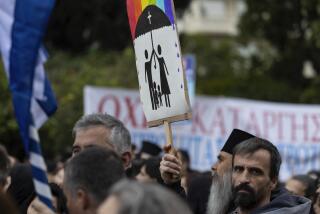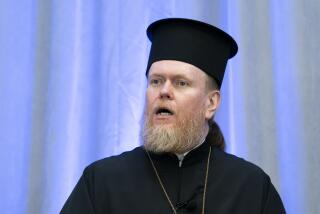Old Religious Differences Again Divide Christians in Eastern European Nations : Worship: Orthodox churches have been reclaimed by Catholics since collapse of communism.
- Share via
LOMNE, Czechoslovakia — Only her well and a shed stand between Maria Hospodarova and the gray village church of St. Michael the Archangel, which used to be hers, but a 1,000-year chasm of distrust is unbridgeable.
For the devout Orthodox Christian, walking to St. Michael next door has become pointless since the majority Catholics reclaimed it in 1990.
“I cannot be a Greek Catholic,” said Hospodarova, 58, a retired collective farm worker. “It is impossible for me.”
She and her neighbors in eastern Slovakia find themselves on the re-emerging line that has divided Eastern and Western Christians since they split in 1054 over differences in belief and practice that began developing in the 5th Century.
The divide slices through eastern Europe from Ukraine to the Orthodox Serbs and Catholic Croats in the war-torn Balkans, separating countless people, including the 300 in Lomne.
Slovakia’s Catholics say they are merely taking back hundreds of churches given to the Orthodox when Communists tried to crush the Greek, or Eastern Rite, Catholic Church after World War II.
Mykola Musinka, a scholar in Presov of eastern Slovakia, said Orthodox Christians like Hospodarova “are being destroyed” in the process. “You cannot erase 40 years of history,” he said.
Even harder to wipe out are centuries of temporal and religious conflict between East and West in eastern Slovakia, western Ukraine and the Balkans. The struggle is reflected in the Greek Catholic Church, founded in the 1600s, which follows Orthodox ritual but obeys Rome.
Orthodox churches reject papal authority, allow their priests to marry and are more or less autonomous by country. The Greek Catholics, ever a bridge, also permit priests to marry.
Josef Stalin exploited religious disunity to stifle nationalism and Vatican influence in the western Ukraine.
First, he co-opted the Russian and Ukrainian Orthodox churches. Then, in 1946, the Soviet dictator outlawed the Greek Catholic faith, gave the Orthodox its property and imprisoned clergy who resisted. Communist Czechoslovakia followed suit in 1950.
Greek Catholicism survived underground and emerged as communism collapsed in 1989 to reclaim its churches in Ukraine.
In 1990, the government of Slovakia, Czechoslovakia’s strongly Roman Catholic eastern third, ordered the Orthodox Church to return everything. Greek Catholics again are the majority, as they were before 1950.
Many churches have been returned, including the one in Lomne, but disputes rage about dozens more.
Orthodox officials accuse Greek Catholics of using “psychological and physical violence” to force their bishop from his cathedral in Michalovce. The Greek Catholics deny it and note that the cathedral once was a Catholic monastery.
Other charges of misconduct have been made by both sides.
The Greek Orthodox Church says two decades of dialogue intended to heal a millennium of distrust are in danger. In February, it accused Greek Catholics of engaging in “persecution, destruction of churches, thefts, arson and other indescribable acts” in Slovakia.
Serb nationalists in Yugoslavia believe the Vatican is behind Germany’s campaign for international recognition of Croatia and Slovenia, both predominantly Catholic.
Alexei II, the Russian Orthodox patriarch, said the Vatican is engaged in “definite expansion.” His church boycotted an ecumenical meeting in Rome last fall.
Imrich Belejkanic, chief of the Orthodox office in Presov, said the Roman Catholics “would like to be much stronger in this region, and they are using the Greek Catholics to do it.” He said the aim is to make Roman Catholics of the Orthodox in Slovakia.
Vatican spokesman Joaquin Navarro said such allegations ignore the facts, Vatican policy and commitments made by Pope John Paul II.
“Particularly surprising are assertions about the Eastern Rite Catholic Church, a community that has had incredible suffering, whose numbers have dwindled in the last few decades,” Navarro said.
Mikulas Hucko of the Greek Catholic bishop’s office in Presov said the Orthodox Church has been victimized more than other faiths by its forced subservience to communism, and the Slovak government must right the wrongs.
“It is the state that perpetrated all these crimes, and it is the state that must settle it,” he said. The concept of restitution, Hucko added, exists “in every normal, legal state. There is nothing unchristian about it.”
Belejkanic, of the Orthodox office in Presov, said Slovakia’s democratic government is treating those who want to remain Orthodox as the Communists did Greek Catholics. “It is a law of liquidation,” he declared.
In Lomne’s microcosm, the problem seems intractable.
The two faiths share an administration building, but their sides of it are separated by a corrugated metal fence.
After Greek Catholics took over the church, Hospodarova said, the Orthodox faithful held services on the grounds outside until the weather grew too cold.
“They think of us like murderers,” she said. “They want us to disappear from this village.”
More to Read
Sign up for Essential California
The most important California stories and recommendations in your inbox every morning.
You may occasionally receive promotional content from the Los Angeles Times.













